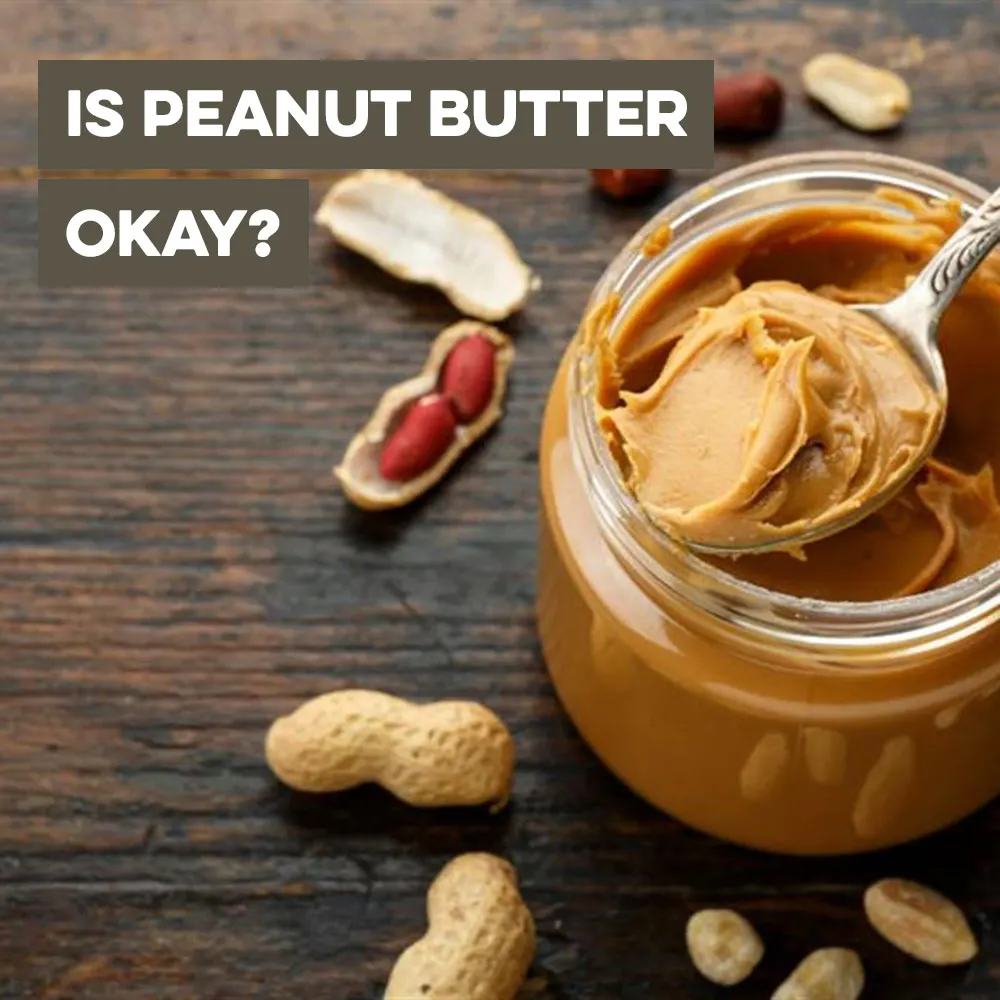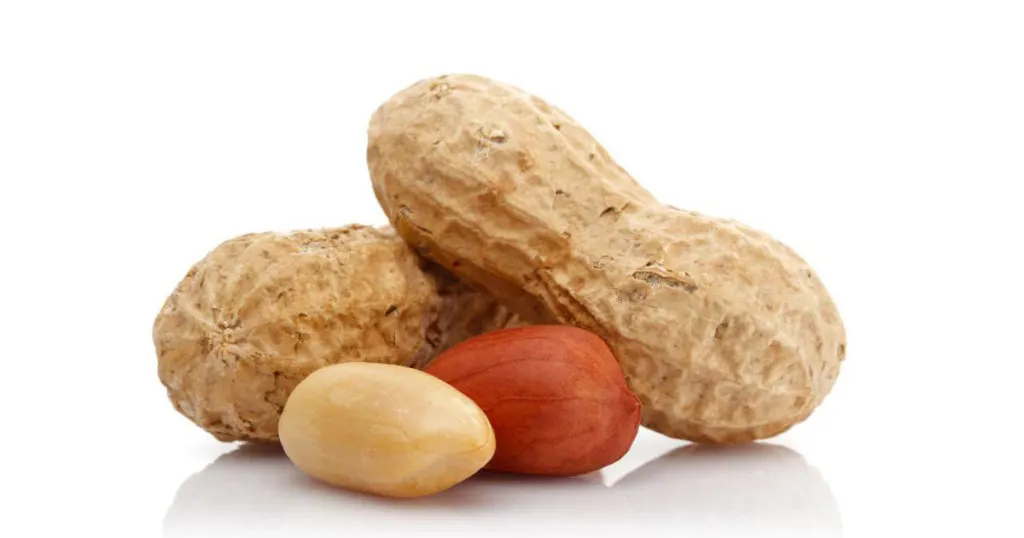If you’re eating low carb, you’ve realized how delicious peanut butter is. In this post we’ll review how many carbs are in peanut butter and what to consider when eating peanut butter.
How many carbs are in peanut butter?
2 tablespoons of peanut butter contain 6 grams of carbohydrate.
How much fiber in a serving of peanut butter?
2 tablespoons of peanut butter have 2 grams of fiber.
What’s the net carbs in peanut butter?
If you’re eating low-carb, you can count on about 4 grams of net carbs per serving. Natural Peanuts and Peanut Butter with no added sugar will not raise blood sugar and are technically safe on a low carb or diabetic friendly diet.

Is peanut butter bad for me?
Peanut butter is delicious. However, there’s a dark side to eating peanuts. One argument, that I’m not really a fan of is that it’s high calorie. That’s true but it’s not necessarily a negative.
Peanut Butter Nutrition Facts
Let’s review a quick the breakdown of macronutrients and calories:
1 gram of Fat = 9 calories1 gram of Protein = 4 calories1 gram of Carbohydrate = 4 calories
This basically means that you get more calories from fat (by weight) than you would from protein or carbs. There’s a raging debate on the impact of calories. Yes, calories are energy. However, quality is more important for health and longevity than quantity (within reason of course). You’d never be able to sustain quality of life by eating only carbohydrates. There’s a significant breakdown of health due to the overconsumption of carbohydrate (at its core, it’s insulin resistance).
Broken down further, fat isn’t going to be an issue if you don’t over consume. Fat in and of itself is NOT going to make you fat. Overconsumption of carbohydrate is much more likely to make you fat. So the high calorie concept, while true, isn’t what you need to be worried about in relation to peanuts. HOWEVEr: if you’re wanting to lose weight, you don’t want to eat loads of peanuts. Yes, all in all, overconsumption of calories isn’t going to help you lose weight.
With the calorie concept out of the way, let’s move on to why peanut butter is actually not ideal for you.
First, let’s review why peanut butter isn’t technically consider “Paleo”.
Peanuts are not Paleo
Being legumes, peanuts are not considered “Paleo”. Here’s the real issue with peanuts, plants defend themselves via anti-nutrients. They can’t bite you or run away. Let’s review some of the anti-nutrients and issues contained in peanuts.
Peanuts Contain Lectins
Lectins are found in raw legumes (aka peanuts). Resistant to human digestion, Lectins may travel into the bloodstream unchanged. We (humans) don’t digest lectins. In fact, our body’s immune system will produce antibodies in hopes of destroying the Lectins.
Not only that but it’s not uncommon for Lectins to damage the lining of the gut wall (contributes to leaky guy).
All in all Lectins may contribute to:
- Joint Pain
- Allergic Reactions
- Headaches
- Autoimmune Issues
- Fatigue
- Brain Fog
Peanuts Contain Saponins
Saponins are known to irritate and damage the lining of the intestinal tract. It’s possible for Saponins to promote chronic inflammation. And chronic inflammation may instigate an immune over-activation. There’s data showing that even prolonged cooking won’t lessen or prevent the impact.
Peanuts and Aflatoxin
Molds and fungus and peanuts, they all go together really well. Did you know that Aspergillus flavus is 20 times more carcinogenic than DDT in pesticides? That’s found in raw peanuts! There is good news on this one… you can dramatically reduce aflatoxin by cooking or roasting.
Peanuts are a poor source of protein
Just imagine eating 10 grams of protein but the protein you actually get is 6,7 or maybe 8 grams. Peanuts have a PDCAAS score about 20-25% lower than animal protein sources. That’s because of a low level of essential amino acids. AND because of the anti nutrient issue discussed earlier.
Aren’t legumes a great source of iron?
They are. However, the form of iron in plants can’t really be absorbed like iron in animal products. Iron in plants is bonded to phytates which reduces the absorption rate by as much as 80%. This is also true with minerals like zinc, also limited by phytates. Ope.
If you have irritable bowels, avoid peanuts
I’ve got an entire post on FODMAP, check it out if you’ve got an unstable gut. Know this: if you struggle with digestive issues and decide to consume beans, legumes (peanuts) often, you’ll end up with a bigger problem and no relief.
Yeah but… do you eat peanuts?
I do but I shouldn’t. And I don’t eat them all the time (even though that would be delicious).
All in all I would say that ideally, we should avoid peanuts. They’re doing us no favors. In fact, we’ve opted to make our commercial kitchen completely peanut free. However, we do sell products in our store that contain peanuts. I would love to be able to make some products with peanuts but I just can’t justify the pros over the cons. There are just too many negatives when it comes to peanuts, especially for those trying to heal.

Peanut Butter Keto Recipes
There are plenty of creative ways to include peanut butter into your meals while still staying within the parameters of a low-carb diet. Here are some keto recipe ideas:
White Chocolate Almond Butter
White chocolate almond butter has a rich, creamy, and nutty taste. The almonds provide a strong base flavor that is slightly sweet, while the coconut oil gives it a smooth and creamy texture. It contains 4 grams of carbs. You can check the full recipe here: White Chocolate Almond Butter – Blanched almonds are a better option than peanuts.
Chocolate Nut Butter Cups
Chocolate Nut Butter Cups are a homemade treat that is made from a combination of chocolate chips, plain nut butter, honey or powdered Lakanto Monkfruit sweetener, salt, and natural colored sprinkles. The result is a delicious treat that has a rich chocolate taste, a creamy nutty taste, and a hint of sweetness from the honey. The naturally colored sprinkles adds a fun touch of color to the treat. More info here: Chocolate Nut Butter Cups
Keto No-bake Chocolate Cookies
Keto No-bake chocolate cookies are a simple and delicious treat that can be made with minimal ingredients and no baking required. This recipe is ideal for those following a keto diet and who likes to enjoy a sweet treat. You could also use your preferred nut butter if you don’t do peanut butter, and the type of chocolate chips you use will change the macros and taste. Check the full recipe here: Keto No-bake chocolate cookies
Thai Peanut Sauce
Thai Peanut Sauce is a flavorful and easy-to-make sauce that can be used as a dip, marinade, or dressing. It is made with a base of peanut butter or almond butter, combined with other keto ingredients. It’s perfect for adding a punch of flavor to noodles, vegetables, and meat dishes. More info here: Thai Peanut Sauce
Peanut Butter Frosting
This is a fun recipe for Peanut Butter Frosting made with natural, no sugar added peanut butter, palm shortening, raw honey, vanilla extract, and sea salt. This frosting is perfect for frosting cupcakes, cakes, or brownies, or even just enjoyed by the spoonful. Its carb content is only 5 grams. You can try to make this at home, for more info click here: Peanut Butter Frosting
Key Peanut Takeaways and Recap
- Generally speaking, peanuts are a low carb option and are okay on a Keto Diet. Peanuts and pure peanut butter with no sweeteners will not raise blood sugar.
- Peanuts are legumes and are not considered Paleo.
- Peanuts contain Lectins which are known to be resistant to human digestion. Lectins trigger your body to produce antibodies in an attempt to destroy the Lectins. Lectins are also known to contribute to: Joint Pain, Allergic Reactions, Headaches, Autoimmune Issues, Fatigue], Brain Fog
- Peanuts contain Saponins which are known to irritate and damage the lining of the intestinal tract.
- Raw peanuts contain Aspergillus flavus which is 20 times more carcinogenic than DDT found in pesticides.
- The protein found in peanuts is a poor source of protein in comparison to animal products.
- Peanuts contain iron. However, Iron in plants (including legumes) is bonded to phytates which reduces the absorption rate by as much as 80%. Translated: the iron in peanuts isn’t enough to justify eating peanuts for iron.
- If you struggle with digestive issues and decide to consume beans, legumes (peanuts) often, you’ll end up worse off. Peanuts contribute to an unstable gut and are considered a FODMAP.

Suzanne
Friday 8th of October 2021
Jungle peanuts are the ones that don't have the aflatoxins in them. They taste the same and are even available on some organic sites.
K
Thursday 21st of October 2021
@Suzanne, I have not heard of jungle peanuts. Expound away….
Maribeth Wagner
Monday 15th of March 2021
Thank you for the information on peanuts. So informative. Now how does Almond Butter stand? I have basically replaced our peanut butter intake with almond butter instead. Thank you, can't wait to get back to FC soon. Maribeth Mediterranean Table Red Feather Lakes CO
Suzanne
Friday 8th of October 2021
@Maribeth Wagner, Rob is totally correct. Yet as a mostly organic eater, there's another issue with almonds. I'm happy to explain if you want to contact me at ss1c59@verizon.net. I'm sure Rob and Kendra don't want to have a lengthy explanation on the website.
Rob Benson
Monday 15th of March 2021
Hi Maribeth!
Almond butter is a better option. If lectins are a worry for you, just get blanched (no skin) almonds. Almonds are also generally mold free too.
See you soon!